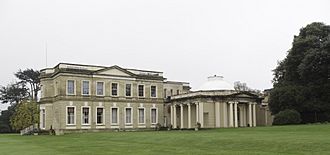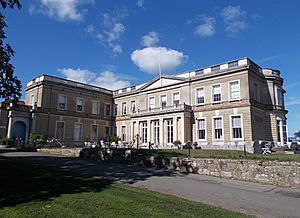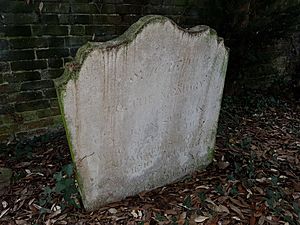Northwood House facts for kids
Quick facts for kids Northwood House |
|
|---|---|

Northwood House (north facing facade)
|
|
| General information | |
| Architectural style | Classical |
| Location | Isle of Wight |
| Town or city | Cowes |
| Country | England |
| Coordinates | 50°45′48″N 1°18′12″W / 50.763402°N 1.303200°W |
| Completed | 1799 |
| Client | George Ward |
Northwood House is a large country house in Cowes, a town on the Isle of Wight in the United Kingdom. The house was built in 1799 for George Ward, a successful businessman from London. His family owned the house for five generations.
Northwood House is a Grade II listed building, which means it's an important historic building. It has a huge ground floor, about 15,000 square feet!
In 1929, the Ward family gave Northwood House and its 26-acre park, called Northwood Park, to the Cowes local council. They wanted the house to be used as offices and the park to be a fun place for the people of Cowes.
After 81 years, the council stopped using the house in 2010. They handed it over to a special group called the Northwood House Charitable Trust Co. Ltd. This group now looks after the beautiful Georgian house and its grounds. Their goal is to keep it safe for everyone to enjoy in the future. The park is open to the public, and the house can be rented for events like weddings, parties, and meetings.
Contents
What is Northwood House used for today?
Northwood House has seven main rooms that people can rent for events. These include the ballroom, dining room, drawing room, morning room, library, rotunda, and the house bar. Wedding ceremonies can be held in six of these rooms. The ballroom is big enough to seat 120 people.
There are also smaller rooms available to rent for longer periods. In the grounds, there's an old stable building that has been turned into The Community Hall. The 26-acre estate also hosts many public events each year. It still has its original tennis courts and a bowling green.
An old icehouse is still in the grounds, partly buried. There are about fifteen icehouses left on the Isle of Wight. You can also find a war memorial in the grounds. It honours those who died in the First World War. This memorial was moved here after it was damaged in an air raid during the Second World War. Now, it remembers people from both wars.
The area in front of the house, which used to be the main entrance, is now a public car park.
A look at Northwood House's past
The Ward family owned the estate from 1793 to 1929. The road in front of the house is even named Ward Avenue after them! They also owned a lot of land across the Isle of Wight.
The Ward Family and their time at Northwood House
George Ward (1793 - 1829)
In 1793, George Ward, a very successful merchant banker from London, bought an estate in Cowes called Bellevue. It had a house and seventeen acres of land.
In 1799, he mostly knocked down the old house and built Northwood House in its place. The grounds were then called Northwood Park. The only part of the old house that remains are the large cellars under Northwood House. George Ward also bought more land, making the estate 217 acres. The long driveway leading to the house was almost a mile long! The famous London architect John Nash designed the changes to the house. Nash also designed parts of Buckingham Palace.
The walls around the estate were built using Bembridge limestone from Brading Harbour.
George Ward's family was already wealthy from successful businesses. His father even won a large sum of money in a lottery! George Ward became even richer by lending money to the government during the Napoleonic Wars. He bought so much land on the Isle of Wight that he owned about one-fifth of the island. People even called him 'King Ward'.
In 1813, George Ward started the first paddle steamer service between Cowes and Southampton. This company later became Red Funnel, which still operates today.
In 1817, a serious disagreement led to a duel at Northwood House. One person, Lieutenant John Sutton, was fatally injured. He is buried in the nearby St Mary's Church graveyard.
In 1821, a big party was held at Northwood House to celebrate the coronation of King George IV. Two thousand poor people from Northwood and Cowes enjoyed a feast. George Ward gave a lot of money to help pay for the food and entertainment.
George Ward had a famous son named William Ward, who was a talented cricketer. He was the first person to score a "double-century" (200 runs or more) in a top-level cricket match. His score of 278 runs in 1820 was the highest for 56 years! William Ward also saved the famous Lord's cricket ground from being sold in 1825 by buying its lease.
George Ward passed away in 1829 at the age of 78.
George Henry Ward (1829 - 1849)
George Henry Ward, George Ward's first son, inherited the estate in 1829. In 1837, he made big changes to the house, adding a new wing and entrance. He also inherited his father's nickname, 'King Ward'.
In 1835, he tried to become a Member of Parliament for the Isle of Wight. He lost the election, but it was a very competitive campaign.
In 1845, Prince Albert visited Northwood House and spent two hours looking at the house and its beautiful grounds. George Henry Ward had spent a lot of money making the grounds look amazing. People thought they had the best collection of evergreen plants in England.
George Henry Ward had no children, so the estate passed to his nephew, William George Ward.
William George Ward (1849 - 1882)
After his uncle's death, William George Ward became the owner. He was a theologian (someone who studies religion) and a mathematician. He wrote many articles about ethics and religion. He also changed his religion from the Church of England to the Roman Catholic Church in 1845.
In 1851, he became a professor. Later, in 1863, he became the editor of a Catholic magazine called the Dublin Review.
For a time, Northwood House was rented out. In 1852, it was used as a Catholic seminary (a school for training priests). Later, it was used as an educational establishment. By 1858, William George Ward was back living in the house.
In 1858, William Ward gave part of the grounds to the people of Cowes. This land was to be used as public walking paths and a playground. His father had been a famous cricketer, so it was suggested that part of the land be used as a cricket ground.
In 1871, Ward moved his family to Totland on the Isle of Wight.
Edmund Granville Ward (1882 - 1915)
When his father died, Edmund Granville Ward inherited the estate. He lived at another house in Cowes, so Northwood House was often empty for several years.
However, Edmund allowed the Royal Yacht Squadron to use the house for a grand ball in 1882. This ball honoured Prince of Wales, who had just become the leader of the squadron. Many important people attended, including the Princess of Wales.
In 1886, the Royal Yacht Squadron held another big ball at Northwood House. This was a truly royal event! The Prince and Princess of Wales were there, along with the Crown Prince and Princess of Germany, and many other princesses and dukes.
In 1889, a large garden party was held at Northwood House. The Prince and Princess of Wales attended again. This party raised money for the local Holy Trinity Church.
In 1891, Prince Henry of Battenberg and his wife Beatrice, who was Queen Victoria's daughter, held a grand ball at Northwood House. Many members of the royal family and 300 important people from the Isle of Wight were there. Queen Victoria even visited the house before the event to see the preparations.
Between 1901 and 1906, Northwood House became a convent for 80 Benedictine nuns. They had to leave France because of a new law. The ballroom was turned into a chapel. The nuns lived a very quiet life and rarely left the grounds.
One of the nuns was Princess Adelaide of Löwenstein-Wertheim-Rosenberg. Her generosity later helped the nuns return to their home in France. In 1902, the new King and Queen visited the nuns at Northwood House. In 1905, the Queen of Saxony also visited. In 1906, Princess Ena, who was soon to marry the King of Spain, often visited to attend mass with the nuns.
In 1906, the nuns moved to a new home in Ryde. Later, in 1909, Northwood Park was turned into a nine-hole golf course.
Wilfrid Philip Ward (1915 - 1916)
After Edmund's death, the estate briefly went to his younger brother, Wilfrid Philip Ward. He was a writer and wrote several biographies, including one about his father. He was also a lecturer and editor of the Dublin Review.
During the First World War, Northwood House was used by the War Office as a Red Cross military hospital. It treated 1894 patients between 1914 and 1919. In 1915, Princess Louis of Battenberg and her daughter Princess Louise (who later became Queen of Sweden) visited the sick and wounded soldiers there.
Captain Herbert Joseph Ward (1916 - 1929)
After his father's death, Captain Herbert Joseph Ward inherited the estate. Like some family members before him, he preferred to live elsewhere. Since the Red Cross Hospital closed in 1919, Northwood House had been empty. In 1919, Captain Ward began selling off much of the family's land. In 1929, he decided to give the house and its remaining 29 acres to the people of Cowes. The house was to be used as a Town Hall and offices, and the land was to become public parks.
The Isle of Wight Council years (1929 - 2010)
In 1929, Captain Herbert Joseph Ward officially gave the house and estate to the Cowes Urban District Council. Princess Henry of Battenberg, as the Royal Governor of the Isle of Wight, received the deeds. The next year, tennis courts were built for public use.
During the Second World War, the house was used as a Red Cross first-aid station. It was also a base for air raid precaution wardens. Parts of the grounds were used to grow vegetables to help with the war effort, and there was an air-raid shelter. In 1940, a charity event was held at Northwood House to raise money for the Spitfire Fund. A captured German plane was even put on display!
In 1947, a bowling green was added to the estate.
In August 1965, over 800 guests, including Prince Philip, attended the Royal Yacht Squadron's annual ball at Northwood House.
In 1998, a developer wanted to turn the house into a hotel. But a group called 'Friends of Northwood House' fought against the idea and won, so the plan was stopped.
From 2002, local citizens started helping to manage the building as "management trustees." The council still used the building, but volunteers also helped look after it. In 2004, the council renovated the downstairs rooms and moved the island's registrar's office (where births, deaths, and marriages are recorded) into Northwood House.
Northwood House Charitable Trust Co Ltd (2010 to today)
In 2010, the Isle of Wight Council completely moved out of Northwood House. This meant that volunteers from the charitable trust were fully in charge of the property.
In 2012, the way the trust was managed changed, and it became the Northwood House Charitable Trust Co. Ltd.
The estate still relies on volunteers to keep it running. They need skilled people like craftsmen, cleaners, gardeners, and landscape designers to maintain the house and its beautiful grounds.



